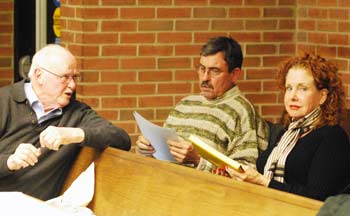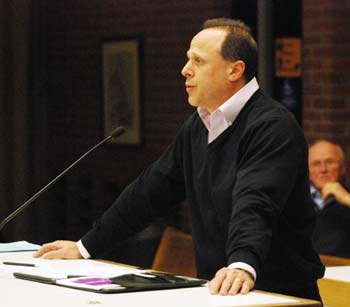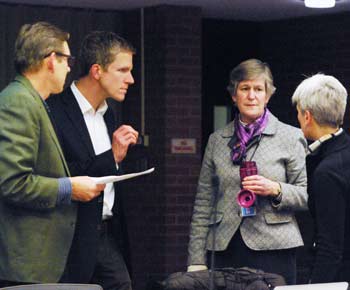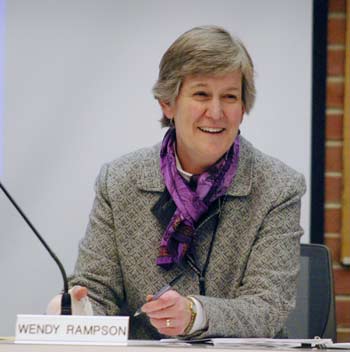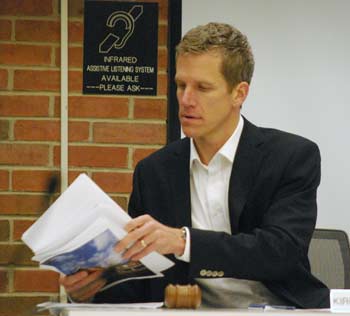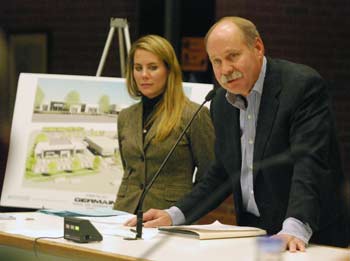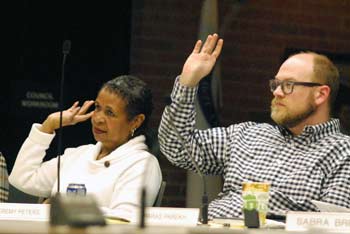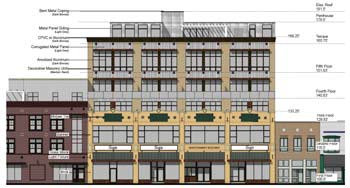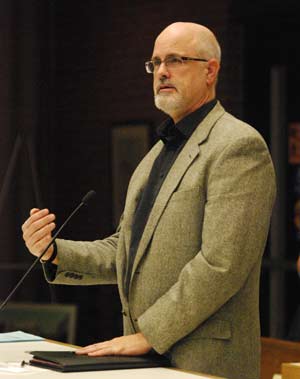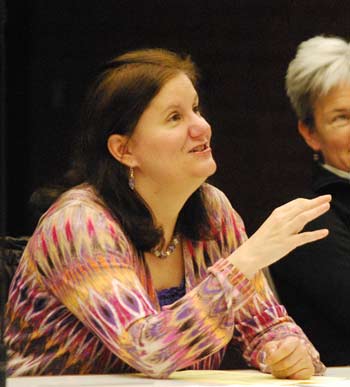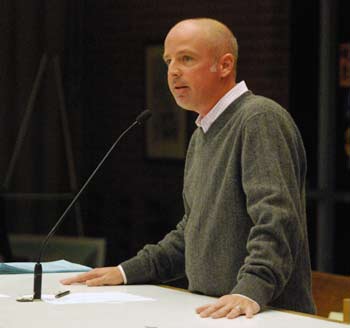Downtown Zoning Review to Wrap Up Soon
Ann Arbor planning commission meeting (Nov. 19, 2013): The main agenda item for the commission’s most recent meeting was a list of draft recommendations that would complete the current phase of a months-long downtown zoning review.

Ann Arbor planning commissioners Eleanore Adenekan and Ken Clein sign papers attesting that these high school students had attended the Nov. 19 meeting. The class assignment did not require that the students stay for the entire meeting, which adjourned at about 12:30 a.m. (Photos by the writer.)
Planning commissioners made decisions on the majority of recommendations for revising the city’s downtown zoning ordinance, but adjourned after midnight before completing their final resolution for city council. Though they did not formally vote to postpone action on the resolution, the item will be taken up again at the commission’s Dec. 3 meeting. [.pdf of revised draft recommendations to be considered on Dec. 3]
Generally, the changes reflect a downzoning in some locations in an attempt to lessen the impact of development on adjacent residential neighborhoods.
A public hearing on the downtown zoning review drew seven speakers, all of whom had previously addressed the commission on this topic. Andy Klein – one of the owners of a site at the southeast corner Main and William, which is being considered for downzoning – spoke against rezoning that property, calling himself the “lone dissenter.” Other speakers at the hearing were in favor of downzoning in general, including at that site. The recommendation for that property – possibly one of the most controversial – was not debated or acted on by commissioners at their Nov. 19 meeting.
Attached to the commission’s Dec. 3 agenda was a communication from Scott R. Bonney of Neumann/Smith Architecture, written on behalf of KRG Investments, the owners of the Main and William property. It suggests a third option to consider as a compromise, and indicates that Bonney will attend the Dec. 3 meeting to make a presentation about this proposal in person. [.pdf of Bonney's letter]
After the planning commission finalizes and approves its resolution regarding these downtown zoning recommendations, the resolution will be forwarded to the city council for consideration. The intent is for the council to review the recommendations and give direction to the commission about which recommendations to implement.
At that point, the commission’s ordinance revisions committee would work with city planning staff to craft actual ordinance language. Any specific ordinance changes would be reviewed by the full commission and ultimately would require city council approval before taking effect. That process would include additional opportunities for public input.
In addition to downtown zoning, three other projects were on the Nov. 19 agenda. Commissioners recommended approval of a proposal to build two restaurants adjacent to Macy’s at Briarwood Mall. They also recommended approval of a four-story addition to the existing two-story building at 210-216 S. Fourth Ave., between East Liberty and East Washington in downtown Ann Arbor, known as the Montgomery Building. The expansion will create 32 new housing units, including four studios, 14 one-bedroom, and 14 two-bedroom units.
One project that didn’t move forward was a proposed expansion of Germain Motors – the former Howard Cooper dealership on South State Street. Owner Steve Germain and his daughter Jessica Germain attended the meeting and described the growth of their business, with a 55% increase in combined sales compared to last year. They indicated that expanded showrooms and additional parking and vehicle display areas are needed to accommodate future growth. However, planning staff recommended postponement to address several outstanding issues, and commissioners acted on that advice.
Downtown Zoning Review
A downtown zoning evaluation began earlier this year, following a city council directive to the planning commission on April 1, 2o13 that was prompted in part by the controversial 413 E. Huron development, at the northeast corner of Huron and Division. The council’s direction was for the planning commission to make recommendations to the city council by Oct. 1.
Planning consultant ENP & Associates was hired to gather public input and evaluate certain aspects of downtown zoning known as A2D2 (Ann Arbor Discovering Downtown), which was adopted in 2009. ENP’s Erin Perdu took the lead on this project.
Her report had been originally presented at the commission’s Oct. 8, 2013 working session. [.pdf of consultant's downtown zoning report] [.pdf of Appendix A: city council resolution regarding zoning review] [.pdf Appendix B: list of downtown development projects since 2000] [.pdf of Appendix C: public input results]
Commissioners held a public hearing on the consultant’s recommendations that began on Oct. 15, 2013, and continued at their Nov. 6, 2013 meeting. They also discussed the recommendations at a Nov. 12 working session. Based on that discussion, planning manager Wendy Rampson made revisions to Perdu’s original set of recommendations. Rampson drafted a memo and resolution containing these revised recommendations, which served as the basis for the Nov. 19 discussion. [.pdf of Nov. 19 memo and draft resolution]
Commissioners made several amendments during their deliberations on Nov. 19, and adopted the following recommendations, which will likely be part of the final resolution to the city council. In general, the changes reflect a downzoning in an attempt to lessen the impact of development on adjacent residential neighborhoods:
- Rezone the parcel located at 336 E. Ann from D1 (downtown core) to D2 (downtown interface).
- Reduce the maximum height in the East Huron 1 Character District (on the north side of Huron, between Division and State) to 120 feet. Include a tower diagonal maximum and consider a step-back requirement to reduce the shading of residential properties to the north.
- Revise the premium conditions to require compliance with Design Review Board recommendations for a project to receive any premium in the D1 or D2 districts.
- Reduce the residential premium with the goal of encouraging the use of other existing or proposed premiums to compensate for this reduction, such as increased energy efficiency certification, open space with landscape, active ground floor use, balconies, and workforce housing.
- Review options in D1 and D2 districts with the housing and human services advisory board (HHSAB) for providing additional affordable housing within mixed-income projects or through other funding mechanisms.
- Eliminate the affordable housing 900% FAR (floor area ratio) “super premium.”
- Evaluate the downtown real estate market to determine the effectiveness of premium incentives every 2-5 years.
The only draft recommendation that was not discussed on Nov. 19 was for a parcel located at the southeast corner of Main and William (425 S. Main). A surface parking lot and a building that currently houses DTE offices are located there.
Commissioners are expected to weigh two options for that site at their Dec. 3 meeting: (1) Rezone the parcel from D1 (downtown core) to D2 (downtown interface) and establish a maximum height of 60 feet for D2 zoning in the Main Street Character District; or (2) Change the maximum height in the Main Street Character District to 100 feet when within 20 feet of a residential zoning district and add a tower diagonal maximum and/or “shadow setback” requirement to limit shading on adjacent residential properties.
For additional background on this process, see Chronicle coverage: “Feedback on Downtown Zoning Continues“; “Downtown Zoning Review Nears Final Phase“; “Priorities Emerge in Downtown Zoning Review”; and ”Downtown Zoning Review Moves Forward.”
Downtown Zoning Review: Public Hearing
The public hearing on the downtown zoning review drew seven speakers – all but one in favor of downzoning. All of them had previously addressed the commission on this topic.
Ray Detter said he was speaking on behalf of the downtown citizens advisory council. The group based its support of the 2009 zoning revisions on the goal of minimizing the negative impact of downtown development on neighbors in terms of height, scale, shading and harm to natural and historic resources, he said. In general, Erin Perdu has done a good job of summarizing the community’s view, Detter told commissioners.
Detter noted that at the Nov. 12 working session, which he and several others attended, they were pleased that the planning commission was supportive of changes to the three locations where the city “made past zoning mistakes,” he said. The advisory council believes the Ann Street lot should be downzoned from D1 to D2, as it’s clearly an interface area across the street from historic properties in the Old Fourth Ward, he said. But it’s also true that D2 zoning should be used for the property south of Ann Street all the way to North Fourth Avenue, he added.
Detter said the advisory council was also pleased that the commission supported decreasing the allowable height of property between Campus Inn and Sloan Plaza from 150 feet to 120 feet, and to use diagonals, setbacks, stepbacks, and a shadow setback requirement to eliminate shading. There should also be at least a 25-foot separation between Sloan Plaza and any development next to it, he said. The advisory council supported rezoning the other parcels on the north side of East Huron between North Division and North Fifth – from 180 feet to 120 feet with possible diagonals, setbacks and stepbacks. That includes the Ahmo’s site, he noted, and the property management office next to Ahmo’s. The 120-feet zoning change should also be extended to include the northeast corner of North Fourth, where a former gas station is located.
Detter said there were cheers during the Nov. 12 working session when it seemed that commissioners agreed that the property at the southeast corner of Main and William should be rezoned from D1 to D2. Apparently that’s still open to discussion, he noted, but the downtown citizens advisory council definitely supports D2 on that entire site. He encouraged commissioners not to give premiums to things that the community doesn’t want – like student housing – but instead to give premiums to features that the community supports, like more open space and affordable housing. Also, the advisory commission supports giving no approvals or premiums unless the development follows recommendations of the design review board, which he said should include a member of the historic district commission.
Jeff Crockett supported what Detter had said, and added that he’s been pleased with the process in that it reflects community input. He encouraged the city in the future to look carefully at the landmark tree ordinance and toughen it up. He liked the idea of D2 on the William and Main site, and also supported creating shadow setbacks as well as a review of premiums every two to five years.
Chris Crockett also thanked the commission for reviewing A2D2, especially in proximity to residential areas. She noted that although the property at Main and William is viewed as a gateway to the city, it’s also adjacent to a residential area and D2 zoning there is as valid as any. She was happy that the commission is reconsidering the use of premiums. People hadn’t understood the ramifications of the original zoning, she said, and didn’t realize that the city would end up with “essentially dormitories.” The premiums haven’t led to good architecture or good development, she said. The city also needs affordable housing, to make sure there’s a good urban mix.
Eleanor Linn told commissioners she hadn’t seem the most recent draft of recommendations before she wrote her comments, so some of the things she was asking them to consider are things that are now in the recommendations. She read her statement, which noted that she lives near the 13-story Landmark “private student dormitory” at South University and Forest. She’s learned something about the problems of high-rise buildings invading residential neighborhoods, she said. Large setbacks are crucial, and she supported 40-60 foot setbacks where D1 or D2 zoning abuts residential zoning. D1 buildings are far too tall to ever abut residential areas. She wants lower height limits where D2 abuts residential, and she hoped the city would review other vulnerable parcels that aren’t included in this current review. She also thinks it’s necessary to reinstate the cash-in-lieu option for affordable housing, if it’s legally possible.
Marc Gerstein also read a statement that had been prepared before he’d seen the updated recommendations. He also lives near South University and Forest, and urged that no D1 zoning should abut residential areas. He supported rezoning the Main and William parcel to D2, and lowering the height limit on the parcel next to Sloan Plaza with bigger side setbacks. He supported shadow setbacks and other requirements that would reduce the impact of D1 and D2 zoning on residential areas. There should always be an interface between D1 parcels and residential areas, and the city should re-examine areas where this occurs – like on the north side of Willard, between East University and South Forest. He also wanted protections for Hill Auditorium and Burton Tower, which are across from D1 zoning on Thayer Street.
Andy Klein introduced himself by saying he was the “lone dissenter.” He’s one of the owners of the property at Main and William, where the DTE building is located. It’s interesting to hear other people’s comments about property that you’ve spent millions of dollars on, he said. He respects the concerns that have been voiced, but there’s no pressure to make any changes on the site. It’s been owned by his family and other investors for over 30 years, Klein said, “and that’s the way it’s going to stay.” Whatever they do with the site in the future will respect the residents and protect the property value, he said, and would be something that the city would be proud of.
Reducing the zoning from D1 to D2 is a “Draconian measure,” Klein said, and is a response to other buildings that have been developed in an “untasteful way.” Every other corner of that intersection is zoned D1, he noted. Lowering the height by 40% could be an option, and adding a diagonal requirement is a flexible solution, he said. “I just don’t think that solutions that are so harsh that they really destroy the potential development of a key site in the city makes a lot of sense.”
Klein noted that his voice is the only one on his side. He can’t come to every meeting and he doesn’t have a group of people to argue vehemently on his behalf. “But my voice is important,” Klein said. His family and other investors have contributed millions of dollars to the city’s tax base, and continue to do so. He urged commissioners not to impose D2 zoning at the site.
[Attached to the commission's Dec. 3 agenda was a communication from Scott R. Bonney of Neumann/Smith Architecture, written on behalf of KRG Investments, the owners of the Main and William property. It suggests a third option to consider: Keep the D1 zoning on that site, but reduce the maximum height to 122 feet and add a tower diagonal maximum of 50% of the maximum diagonal dimension of the site. The letter, which includes diagrams showing the impact this proposal, indicates that Bonney will attend the Dec. 3 meeting to make this presentation in person.] [.pdf of Bonney's letter]
The last speaker Doug Kelbaugh, who said he was speaking as a private citizen. [Kelbaugh is a professor at the University of Michigan College of Architecture and Urban Planning.] It’s been a “very productive if tedious process for you,” he told commissioners, but he was in favor of continuing it in some way. He knew there were no additional funds for consultants, but he hoped the commission would ask the city council for more funding to continue the zoning review beyond the current scope.
In particular, he hoped they could look at extending some of their “wise decisions.” For example, he hoped to extend the zoning changes next to Sloan Plaza, with lower height limits, all the way along the north side of Huron to Main Street, or perhaps even further west to Ashley or First. The changes at Division and Ann should also be extended all the way to Main Street or further, he said. Other edges of the downtown – like the church site at Huron and State Street, and the block of Thayer – need to be re-examined, where D1 zoning hits the UM campus. Kelbaugh hoped the city could find the wherewithal to continue its zoning review.
Downtown Zoning Review: Commission Discussion – Affordable Housing
The commission considered this draft recommendation regarding affordable housing:
- Revise the affordable housing premium so that the provision of affordable housing or a contribution-in-lieu of affordable housing is mandatory for receiving any premiums in the D1 or D2 districts.
In reviewing the proposed recommendations at the start of the Nov. 19 discussion, planning manager Wendy Rampson noted that the draft recommendation to add a contribution-in-lieu as an option for the affordable housing requirement was seen as problematic by the city attorney’s office. Any type of in-lieu-of payment is very difficult in Michigan because the state statute does not clearly indicate that it can be done, she reported. It’s more straightforward with elements like parking, she added. But with affordable housing, it’s harder to draw a connection between the need for affordable housing in one location, and addressing that need through a payment to the affordable housing trust fund, which can be used to support affordable housing anywhere in the city, not just downtown. The commission could still include it in their recommendations, she said, but as it moves to city council, it might be tempered by advice from the city attorney.
Kirk Westphal highlighted a communication regarding a more detailed recommendation that had been approved by the housing and human services advisory board (HHSAB). It was included as part of the planning commission’s meeting packet. [.pdf of HHSAB recommendation] The HHSAB recommended modifying the premiums to require building affordable housing or making a cash-in-lieu contribution to affordable housing, and included a detailed formula for calculating contributions:
(i) For purposes of obtaining any premium listed in (_______) above, developments less than 400 FAR shall provide 10% of the total square footage as dwelling units affordable to very low income households. Projects exceeding 400 but less than 700 FAR shall provide 15% of the total square footage as dwelling units affordable to very low income households.
(ii) Payment in Lieu Formula, Discretion of City Council to Allow. Dwelling units affordable to very low income households shall be provided by the development of units on-site, or through an affordable housing contribution “in lieu of” units. The amount shall be set consistent with a “payment in lieu” formula set by recommendation of the HHSAB annually by the end of March each year and submitted to City Council for approval or rejection.
(iii) Calculation for Pro Rata Amounts. When the affordable housing requirement results in a fractional unit, the fractional unit shall be converted to an affordable housing contribution in lieu of units, using the following formula: the fraction shall be multiplied by the per-unit affordable housing contribution as determined by the formula adopted annually by City Council.
(iv) Recommendation of Planning Commission, Approval of City Council required. For each proposed development utilizing a premium to exceed base FAR, the Planning Commission shall recommend approval, approval with conditions, or denial, and City Council, in its sole discretion, may approve or deny payment of an affordable housing contribution in lieu of all or part of units on site.
Westphal wondered whether commissioners would be able to “button down” the legal issue that night related to the contribution-in-lieu approach to affordable housing. Rampson indicated that it would not be possible to determine that at the meeting. She also didn’t think the issue could be handled in isolation from other recommendations.
Sabra Briere asked Rampson is there’s any scenario that she’s heard the city attorney support when it comes to cash-in-lieu for affordable housing. Rampson noted that the planned unit development (PUD) approach includes a contribution-in-lieu option. That’s possible because a PUD is “a very special animal under state law,” she said.
But in a standard zoning district, the only requirement for affordable housing is if a developer wants to secure premiums. The question becomes whether there’s a nexus between that requirement and making a payment into a fund that won’t necessarily result in what you’re looking for – affordable housing in the downtown. So one possibility might be to create a separate fund to be used only for affordable housing downtown, Rampson said. But according to the city attorney’s office, even that might not be sufficient, she added.
“Any time you’re asking people for money in exchange for approval of zoning, there is some discomfort about that,” Rampson said. It’s different when you ask for requirements like parking or landscaping, she said. Requiring affordable housing is a bit of a stretch in Michigan, she noted, but it’s the contribution-in-lieu option that becomes really problematic.
Ken Clein said he’s in favor of affordable housing downtown, but he pointed out that you can build a lot more affordable housing outside of the downtown, where land prices are lower. Rampson replied that if you require contributions to affordable housing that can be spent outside of the downtown, you’d be creating an island in the downtown where affordable housing isn’t deemed appropriate – that’s one way of looking at it, she said.
Briere noted that at the Nov. 18 city council meeting, the council had revised the ordinance regulating the Ann Arbor Downtown Development Authority. Starting in FY 2016, the DDA will put aside $300,000 annually to use on affordable housing within the DDA’s boundaries or within a quarter mile of those boundaries. It will be challenging, Briere said, but the goal is to encourage affordable housing downtown. She wondered if the zoning could require affordable housing as a gateway for getting a housing premium.
Rampson replied that because seeking a premium is optional, that might be possible. Briere pointed out that it might then discourage the development of housing altogether.
Bonnie Bona felt that the most effective approach to affordable housing is when it’s part of a mixed-income development. If the city collects affordable housing funds and steers those funds toward property that’s less valuable, “we’re actually segregating,” she said. The gap in housing options is big enough that it requires multiple approaches, Bona said. She wondered if the recommendations to the council can include a recommendation to look more deeply into this issue, working with the city’s housing and human services advisory board.
Later in the meeting, Bona proposed a revised recommendation: “Review options for providing additional affordable housing within mixed-income projects and through a fund, with the assistance of the housing and human services advisory board.”
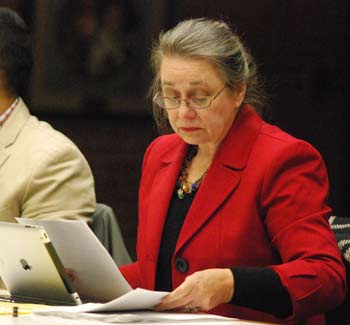
Ann Arbor planning commissioner Sabra Briere, who also serves on the city council representing Ward 1.
Paras Parekh asked whether they needed to specify D1 and D2 districts, or whether the recommendation was for the whole city. Bona felt it’s an issue for the entire city, but the downtown zoning review is why it’s being addressed. She didn’t want to be restrictive.
In response to another query from Parekh, Bona said the phrase “mixed-income projects” is to prevent segregating affordable housing into one location. “We don’t want housing projects, if we can help it,” she said.
Wendy Woods was concerned about including a reference to the housing and human services advisory board (HHSAB). She didn’t feel the recommendations should be so specific at this point. She made a motion to strike that reference from the recommendation.
Ken Clein said he didn’t feel strongly about it, noting that the commission can always consult with other entities if it wants to. But if the recommendation specifies the HHSAB, he wondered whether they should also specify consulting with the city attorney’s office. The suggestion elicited a laugh from commissioners. Clein said his point is that the recommendation might be getting “too in the weeds” by specifying who they’ll consult.
Rampson noted that HHSAB did provide very specific feedback to the commission regarding the affordable housing issue.
Bona thought that including a reference to HHSAB acknowledges that the commission has received that feedback, and that it’s important. Affordable housing also is a complicated topic – much more so than something like LEED certification, she said. Affordable housing has been a problem for centuries, Bona added, and the city doesn’t seem to be any closer to a solution.
Outcome on amendment to strike the reference to HHSAB: It failed on a 1-8 vote, with support only from Wendy Woods.
Commissioners also discussed the phrasing “and through a fund.” Bona said she’d stayed away from saying “payment-in-lieu” because of concerns that the city attorney’s office had raised.
Clein suggested using the phrase “or through other funding mechanisms” instead. It was accepted by Bona as a friendly amendment.
Another amendment was suggested by Woods, to add “D1 and D2 districts.” Bona said she wanted to leave it vague. She pointed out that the title of the overall resolution is “Recommended Downtown Zoning Amendments.” She thought that adding D1 and D2 would be redundant, and noted that it’s not included in the other recommendations.
Woods pointed out that earlier in the evening, commissioners had discussed concerns about possibly locating affordable housing outside of the downtown. That’s why she wanted to be more specific.
Outcome on amendment to add D1 and D2: It passed on a 6-2 vote, over dissent from Bonnie Bona and Jeremy Peters. Sabra Briere was out of the room during the vote.
The final revised recommendation states:
Review options in D1 and D2 districts with the housing and human services advisory board (HHSAB) for providing additional affordable housing within mixed-income projects or through other funding mechanisms.
Outcome: Commissioners voted unanimously to make this recommendation.
Downtown Zoning Review: Commission Discussion – Residential Premiums
Commissioners discussed how to combine these two separate items from the draft resolution:
- Reduce the residential use premium from 0.75 sf to 0.25 sf per square foot of residential use to encourage the use of other premiums.
- Include other types of premiums in addition to the ones currently available.
The consensus was to make the first recommendation less specific, and to include several examples of the types of premiums that commissioners would like to see. Affordable housing was left out in favor of a broader goal of workforce housing.
Jeremy Peters suggested a premium of the shadow setback, but when planning manager Wendy Rampson asked whether commissioners wanted that as a premium or a requirement, the consensus initially was to recommend shadow setbacks as a requirement.
Ken Clein suggested making LEED silver certification as a premium. Rampson reminded commissioners that LEED certification is already included as an A2D2 premium – silver, gold and platinum certification can result in additional floor-area ratio (FAR). Only two projects so far – at 618 S. Main and 624 Church St. – have proposed using LEED certification as a premium, she reported. And because the developer of 618 S. Main subsequently scaled back that project, that premium isn’t needed. There are also energy efficiency “points” that are required as a gatekeeper to securing premiums.
Bonnie Bona counseled against being too specific at this point regarding LEED certification, and suggested a more general recommendation of increasing the energy efficiency requirements as a premium.
Sabra Briere noted that the LEED premium is the only one that comes with a penalty. That is, if you get a premium to build additional FAR on the premise that the building will be LEED-certified, but it doesn’t achieve that status, then there’s a financial penalty. “I’m not going to even try to replicate the incredibly complex equation that nobody understood sitting around the table except maybe the person who was proposing it – and maybe not,” she said. But it reminded her that when the city grants premiums, there’s an expectation that the city will reap a benefit. One option would be to look at applying a cash penalty for other premiums that aren’t met. She described her suggestion as “a very unformed thought.”
Later in the discussion, Briere pointed out that the directive from council was not to rewrite the zoning ordinance at this point. It was to make broader recommendations. What’s needed is for the council to clearly define the problems that it wants the planning commission to address, and at that point the commission can work on revising the ordinance. Getting into details at this point could really bog down the work, she said.
Rampson cautioned that if the commission sent recommendation to the council that are too general, the subsequent direction from council might not be clear. Briere countered that if the planning commission is too specific, it could result in some councilmembers pushing back because they don’t like the specifics. Briere indicated that if the commission looks like it’s done all the work, that’s not a good approach.
Rampson also pointed out that if more options are provided as premiums, it might dilute the ability to encourage any one particular goal, like residential development.
The final revised recommendation states:
Reduce the residential premium with the goal of encouraging the use of other existing or proposed premiums to compensate for this reduction, such as increased energy efficiency certification, open space with landscape, active ground floor use, balconies, and workforce housing.
Outcome: This recommendation was passed unanimously.
Briere suggested eliminating another recommendation related to residential premiums, which she felt could be addressed elsewhere:
- Revise the residential use premium to be more specific about the types of units that will be eligible for premiums.
Bona agreed, saying she was very opposed to having premiums for specific unit types that could be reconfigured soon after a building is constructed. The buildings need to be designed to be flexible, if they’re going to last a long time, she added. One possibility is to require that developers show the interior design during the site plan phase, to show that the interior could be flexible, she said.
Clein agreed with Bona, saying it would be very difficult to enforce any kind of interior requirement.
Outcome: This recommendation was eliminated on a 7-2 vote, over dissent by Eleanore Adenekan and Jeremy Peters.
Downtown Zoning Review: Commission Discussion – East Huron
Commissioners discussed two related draft recommendations for the East Huron area:
- Reduce the maximum height in the East Huron 1 Character District to 120 feet and add a tower diagonal maximum and/or “shadow setback” requirement to limit shading on adjacent residential properties.
- Rezone the block bounded by Huron, Division, Ann and Fifth Avenue from E. Huron 2 Character Overlay District to East Huron 1 Character Overlay District.
Wendy Rampson explained that if these recommendations are approved, the height limits for properties adjacent to city hall and the University of Michigan Credit Union site – currently a parking lot off of Ann Street, next to city hall – would be reduced from 180 feet to 120 feet.
Kirk Westphal clarified with Rampson that owners of those properties weren’t interviewed for this zoning review. He said he wouldn’t be comfortable making the changes proposed for the East Huron 1 Character District, adding that it’s beyond the scope of the council directive.
Diane Giannola said she’s not in favor of shadow setbacks. She wondered how it would affect property rights. Shadows come from everything, including trees, she said, “and when you own property, you don’t necessarily own the sun.” The concept is way too vague, she added, and she’d rather see diagonals used to address the issue of shadowing.
Jeremy Peters didn’t think it was fair to talk about trees in this context. It’s clear that the shadow setbacks refer to buildings, he said. He didn’t support removing it.
Sabra Briere voiced concern over investments that people make in solar panels and alternative energies that rely on solar gain. What happens when something happens next door that shades the investment? It’s a different set of property rights at stake, she said, compared to the rights that Giannola mentioned. Briere supported the idea of shadow setbacks, because the city is encouraging alternative energy investments and they need to be protected. “We have to come up with a way to balance the individual’s rights with the community’s rights,” Briere said.
Westphal was cautious about introducing a completely new tool at this point, and would prefer to stick to responding to the council’s charge.
Paras Parekh wondered why the shadow setbacks were only proposed for the East Huron 1 Character District, and not elsewhere. On philosophical grounds, he had concerns about requiring something in one part of the city that wasn’t required anywhere else.
Rampson noted that Briere’s concerns are more related to solar access law, and the shadow setback requirement wasn’t intended to regulate solar access. The reason Rampson included a mention of shadow setbacks in the draft was because commissioners had discussed the issue at the Nov. 12 working session. It was specified for that particular part of town because of D1 zoning that abuts residential neighborhoods located to the north, “which is probably the worst shadow configuration that you could get,” Rampson said. Perhaps there’s a better term to use instead of shadow setbacks, she added.
Ken Clein agreed that solar access rights are best left for longer-term study.
Bonnie Bona noted that this section of East Huron is the only area where D1 zoning is directly adjacent to residential. She described this part of the downtown zoning as a “major flaw” in the final A2D2 zoning. She thinks an interface district is needed around the entire downtown, but “we need it here more than anywhere.” Especially in the winter, there’s a lot of shade. If the shadow setback isn’t included, Bona said she’d then support rezoning that area to D2. She noted that the Sloan Plaza site could also be built to a greater height, which would impact the residential neighborhood to the north.
Briere cautioned against rewriting the East Huron 1 Character District – in terms of height and shadow setback. That’s too ambitious to do on the fly at midnight, she said. Instead, Briere proposed recommending that the East Huron 1 Character District be revised.
After further discussion – which included distinguishing between “setback” and “step-back” – commissioners reached a compromise wording:
Reduce the maximum height in the East Huron 1 Character District (on the north side of Huron, between Division and State) to 120 feet. Include a tower diagonal maximum and consider a step-back requirement to reduce the shading of residential properties to the north.
Outcome: The revised recommendation was unanimously approved.
Regarding the draft recommendation to rezone the block bounded by Huron, Division, Ann and Fifth Avenue from East Huron 2 Character Overlay District to East Huron 1 Character Overlay District, commissioners were reluctant to make that specific recommendation at this time. Clein noted that it wasn’t part of the charge from the city council. Westphal said he’d be willing to strike it.
Clein and Peters both suggested that instead of this recommendation, the commission should create a separate recommendation that would focus on review of additional sections of the downtown.
Outcome: Commissioners unanimously voted to strike the draft recommendation to rezone block bounded by Huron, Division, Ann and Fifth Avenue.
Downtown Zoning Review: Commission Discussion – Review of Other Areas
Ken Clein proposed adding a new recommendation to request that the planning commission review any area where D1 zoning directly abuts or is within 25 feet of residential or historic districts, and to review whether those areas should be rezoned to D2 or whether to modify the zoning in these sensitive areas.
Sabra Briere noted that one area where D1 abuts an historic district is on Main Street. About a third of the block between Liberty and William is not in an historic district, and is zoned D1. “The day that someone proposes a 180-foot tall building [there] is a day that this body will … hear from the public about problems with that,” she said. Briere noted that other areas have been mentioned by members of the public as problematic, including Thayer Street, South University, and some parts of Forest, for example. She supported Clein’s recommendation.
Diane Giannola felt that if any area abutting an historic district must be rezoned, then there likely won’t be any D1 zoning downtown – because there are so many parts of downtown that are designated historic districts. Jeremy Peters noted that Clein was suggesting only to review those areas, not to actually make recommendations at this point.
Wendy Rampson clarified that the current review already includes all the areas where D1 directly abuts residential. The review does not include areas that abut historic districts, she added.
Giannola thought Clein’s proposal was outside of the council’s charge, and that it would require an entirely new study, starting the process all over again. Bonnie Bona also said she didn’t support the proposal.
Briere noted that the planning commission and council have heard from people who want the city to review all character districts. It’s true that it wasn’t in the council’s charge to the commission, she said, but people have brought it up. She suggested recommending that the council consider whether all the areas that aren’t zoned D2 need to be re-evaluated.
Rampson pointed out that the planning commission and staff spent six years creating the A2D2 zoning, which was just adopted in 2009. “If you are really opening the door to rethinking all of the character districts, are you really ready to say that’s a priority, given your work program – to revisit everything in the downtown?”
Briere said the only way to get more specific direction from council is to put a resolution on the council agenda, which she was reluctant to do. Instead, she wants to take a “deep dive” into the Redevelopment Ready project, to see if the city’s existing ordinances match its master plans. She’d also like to get the ZORO (zoning ordinance reorganization) project completed, before taking on something else. She said she was struggling to find a way to indicate that the commission has heard the problems that people have raised.
Wendy Woods noted that for sites next to the University of Michigan, it didn’t make sense to be overly concerned about zoning. “The university can change what it has on campus next year, if they want to. We could be worried about shadowing Hill Auditorium, and it could be gone – because that’s the reality.” She thought the commission should focus on what it was asked by council to do.
After some additional discussion, Clein offered to withdraw his proposal.
Outcome: Clein withdrew his proposed recommendation.
Downtown Zoning Review: Commission Discussion – Other Recommendations
Two draft recommendations were accepted without substantive discussion:
- Rezone the parcel located at 336 E. Ann from D1 (downtown core) to D2 (downtown interface).
- Revise the premium conditions to require compliance with Design Review Board recommendations for a project to receive any premium in the D1 or D2 districts.
Downtown Zoning Review: Commission Discussion – Adjournment
At about 12:30 a.m., commission chair Kirk Westphal said he wasn’t prepared to tackle the remaining draft recommendations. He offered to entertain a motion to adjourn.
Outcome on adjournment: The motion passed 8-1, over dissent from Jeremy Peters.
Downtown Zoning Review: Commission Discussion – Final Public Commentary
After adjournment, Westphal realized he had omitted the final public commentary. The only person remaining was Ray Detter, who told commissioners: “I’ve got a lot to say, but you’re not really interested in hearing it.”
Germain Motors Expansion
Earlier in the meeting, commissioners discussed a proposal to expand two buildings and the parking area for Germain Motors – the former Howard Cooper dealership on South State Street. Planning staff had recommended postponement, to allow the owners to address staff feedback on the project.
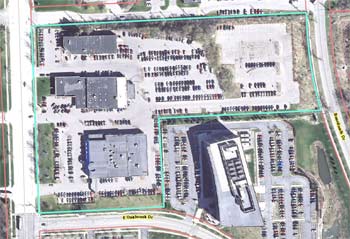
Aerial view of Germain Motors site, outlined in green. South State Street is on the left (west) side of this property. Expansion is proposed for the two smaller buildings on the north and center of the site that fronts South State.
The proposal calls for a 4,877-square-foot addition to the Volkswagen building on the northern portion of the State Street frontage, bringing the total square footage to 18,722 for that structure. A 6,429-square-foot addition is proposed for the Porsche/Audi building, in the center of the site, which would create a total building size of 31,097 square feet. The site’s third building, housing the Honda dealership on the southern part of the property, would remain at 36,101 square feet.
Also, the owner – Steve Germain, who attended the Nov. 19 meeting with several members of the project team – would like to add 248 parking spaces, bringing the total number of spaces to 1,039. The new spaces would be in three locations: (1) along the southern half of the South State Street frontage; (2) along the Oakbrook Drive frontage; and (3) in the rear car storage lots. The proposal would require three variances from Chapter 59 (off-street parking) in order to allow tandem parking, to reduce the aisle widths, and to exceed the maximum percentage (30%) of allowable small car parking spaces.
The owner also wants a variance from Chapter 62 (landscaping) to eliminate the requirement for interior depressed landscape islands in the car inventory and display areas.
The total expansion is estimated to cost $5.5 million. In a staff memo, city planners called the project an upgrade to the appearance of the site, but also cited several concerns.
The work would result in the loss of three out of four landmark trees on the property, to be mitigated by planting 11 additional trees. City staff were concerned by that reduction in landmark trees, as well as by the proposed request for planting fewer interior landscaping trees. Another concern was the additional amount of impervious surface that would be created by this expansion.
That was also an issue cited by the Malletts Creek coordinating committee, a group that includes representatives from the city, the office of the Washtenaw County water resources commissioner, the Huron River Watershed Council, and Pittsfield Township. That committee, which is focused on improving the condition of the Malletts Creek watershed, felt that a variance might be justified or mitigated only if the project included offsetting stormwater management on the site – such as green roofs, sand filters, or other low-impact development techniques.
Germain Motors Expansion: Public Hearing
Four people – all affiliated with Germain Motors and its proposed expansion – spoke during a public hearing on the project.
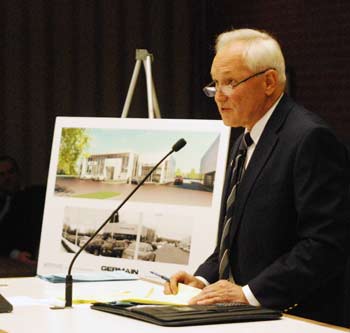
John Oney of Architectural Alliance, the architect for an expansion of Germain Motors – formerly the Howard Cooper dealership on South State Street.
John Oney of Architectural Alliance in Worthington, Ohio, gave an overview of the project. He said it’s their goal to work through any issues and hopefully agree to any conditions that the city deems to be appropriate so that the project can move forward as quickly as possible.
The existing site was “piece-mealed together,” Oney said, so they’d like to develop a comprehensive master plan to upgrade the buildings to the new “image requirements” of the auto manufacturers, to address the working needs of the business as it expands, and to improve the State Street corridor and the dealership’s customer experience. The new design is intended to provide connecting pedestrian walkways throughout the campus, as well as additional landscaping and upgraded building materials, he said.
Oney showed some architectural renderings of the buildings, then introduced Steve Germain. He said Germain had taken “a leap of faith here in these uncertain economic times to acquire the dealership and make some significant improvements.”
Steve Germain, owner of Germain Motors, began by introducing his daughter, Jessica Germain. He told commissioners that they live in Columbus, Ohio, “but don’t hold that against me, please.” He noted that Jessica Germain is a 2004 graduate of the University of Michigan, with strong ties to this community. One of her responsibilities is to help manage this region, and he said he was proud of her work.
Germain described how his business had acquired most of the assets of Howard Cooper Imports about a year ago, noting that Cooper has been a member of this community for over 45 years. They purchased the three dealerships on South State Street, and the rights to four franchises. They took over a business with a great reputation both in the industry and in this community, he said. The business employs 92 people, Germain reported, saying it was an honor to carry on a tradition with such wonderful employees in a vibrant market.
In order for the business to continue to grow and prosper, Germain added, they need to do three things. They need to upgrade the facilities to meet the requirements of the manufacturers. They need to provide ample, safe and convenient parking to enhance the customer experience and allow the business to create more jobs. Third, he said, they need to maximize their storage capacity and grow their inventory to meet the market demand.
Jessica Germain then reviewed the sales for the past 10 months. She said the business has achieved significant growth, beyond industry averages. Ann Arbor’s demographics align with Honda’s target buyers for fuel-efficient and economic products, she said. Honda sales from January through October of 2013 have exceeded last year’s sales by 31%.
Volkswagen sales are up 40% compared to last year, she reported, and sales for Audi have increased 76%. The business services both the Ann Arbor and Toledo markets for the luxury brand of Porsche, Germain said, and sales have increased 89% in 2013 compared to the first 10 months of 2012. In the sale of pre-owned (used) cars, sales are up 108% in 2013.
Strengthening the inventory for new and pre-owned sales gives the business an opportunity and range of price points to provide in this market, she explained. Overall, they’ve seen a 55% increase in combined sales, but she said the business still hasn’t met the requirements and expectations of manufacturers. Germain Motors aspires to exceed those requirements, she added.
Steve Germain spoke again, saying that when they acquired the business in September 2012, they soon realized that the potential in this market with these brands would require that they expand the inventory. Their first thoughts were for off-site storage, he said, but it’s not recommended because of the costs involved in security, fencing and shuttling cars back and forth. They also considered a parking deck, but the cost at about $18,000 per space would put the total cost at over $3.6 million. He indicated that the proposal that was before the planning commission is the best approach.
Bob Wanty of Washtenaw Engineering, the project’s civil engineer, noted that there are three issues that the planning staff raised. One is the increased amount of impervious surface. The city also would like to add additional landscaping islands and address some stormwater management issues. The landscaping islands that the city is requiring are located in the storage area, Wanty said, but he argued that the requirement of landscaping islands should apply to parking for the public, not for storage.
Regarding staff concerns over a “heat island effect,” Wanty noted that over 50% of the vehicles sold are lighter in color – silver and white – and these cars would be parked there 24/7. He contended that the site plan exceeds the city’s requirements for interior landscape island area by 2,300 square feet. Wanty noted that the soil is mostly clay, so the landscape islands don’t really result in infiltration. The site has a very good stormwater management system, he said. He described the system, and noted that it meets the county water resources commissioner’s standards.
Germain Motors Expansion: Commission Discussion
Bonnie Bona asked about the requested landscape modifications, and wanted to know whether there are any alternatives if the required landscaping can’t be provided on site – such as planting trees at another location. City planner Matt Kowalski replied that there’s an option of planting trees to mitigate the removal of landmark trees, but it has to occur on public land and meet other standards, such as proving that the mitigation can’t occur on site. The city’s natural features coordinator didn’t feel Germain Motors had met that requirement, he said. This applies only to mitigation trees, Kowalski noted. There are no options like that for trees required under the city’s landscaping ordinance, other than a variance.
Bona pointed out that 103 trees are required to be planted, but the proposal calls for planting 95 – eight trees short of the requirement.
Bona asked about the extension of the parking 32 feet toward State Street, on the south side of the site. Bob Wanty of Washtenaw Engineering replied: “That is not parking. That is display.”

From left: Ann Arbor planning commissioners Diane Giannola and Bonnie Bona, and city planner Matt Kowalski. Kowalski was recently elected to the Dexter city charter commission.
Bona referred to the presentation that Kowalski had given earlier in the meeting, which included a slide that showed cars parked on the lawn. “I can’t let that go,” Bona said. She asked whether the business is proposing to pave that area. Yes, Wanty replied. Are those cars allowed to be parked there now? she asked. “They’re not there,” Wanty said. Kowalski noted that the cars were parked there that morning, prompting Steve Germain to call out: “But they won’t be there tomorrow.”
“This is a huge amount of parking,” Bona said, so the total number of required trees and the depressed landscape islands need to be provided. She understands that their business requires a lot of parking, and that the site is sloped so there area certain areas where parking can’t be located. Because the parking doesn’t directly benefit the public, she said, “I think you have even more of a responsibility to help Tree City plant urban trees in areas that are impervious.” She wouldn’t be voting in favor of a variance. “You’ve got to do your fair share.”
Sabra Briere said she wanted to echo Bona’s comments, saying that an area to display vehicles is still parking. Adding impervious surface impacts the Malletts Creek area, especially since that area has clay soil and the Malletts Creek system is already overwhelmed, Briere said. For her, the big issue is that there will be a lot of polluted water running off that surface.
Ken Clein asked whether other dealerships in town have asked for variances to not put in landscape islands and trees. Kowalski wasn’t sure how many dealerships are left in Ann Arbor. There’s Varsity Ford, but that dealership hasn’t done any recent renovations, he said. There was a Fiat dealership project, but no variance had been requested for that. [Planning commissioners had recommended approval of the Fiat project on West Stadium Boulevard at their Aug. 21, 2012 meeting.]
Clein said he agreed that the requirement for landscape islands shouldn’t be waived, and that the full amount of trees should be planted to mitigate the removal of landmark trees. Otherwise, it would seem like the city is giving the business a free pass, he said. The purpose of planting trees isn’t just because Ann Arbor is Tree City, he said, but because it helps mitigate the impact of climate change a little. “Those eight trees may not save the world, but those eight trees done again and again and again may help,” Clein said.
Paras Parekh asked why the business didn’t feel that the eight trees could be added to the site. Wanty replied that the trees could probably be squeezed onto an area on the site’s slope, but vegetation is already located there and it’s “like a jungle.” Putting in more trees would disturb the existing vegetation, he said, and create the potential for erosion. He noted that the city requires the mitigation trees to be interior to the site, not on the perimeter.
Rick Meader, a landscape architect with Washtenaw Engineering, came to the podium. He said the landmark trees are only characterized as landmark in aggregate. They aren’t “big, majestic oaks,” he said. Three of them are box elders that are being replaced with better trees, he said, including oaks and tulip trees.
In response to a query from Kirk Westphal, Kowalski said the business submitted one alternative plan, which included a parking structure on the lower level of the site. It didn’t result in any landmark trees being removed. Westphal wondered if there were a middle option, in order to preserve the trees but still provide the amount of desired parking. Kowalski replied that there might be other options – such as quadruple stacking – but probably anything would require some sort of variance.
Westphal wondered if quadruple stacking was possible. Wanty said they didn’t look at that option, and it would entail re-aligning the aisles and spaces. It was something they could look at, he said.
Wendy Woods noted that the Malletts Creek coordinating committee had suggested some options, like the use of green roofs and other low-impact development techniques. She wondered whether the business would consider any of these.
Wanty replied that the site currently drains into a sediment forebay, then into a wetland, then into a second wetland – before it enters Malletts Creek. It’s a good system to break down any oils, he said, and there’s very little silt or sediment that comes off of the site. The new cars don’t leak the fluids that older cars would leak, he noted. “So we’ve really got a clean site here,” Wanty said. That’s why they felt that additional stormwater management wasn’t necessary.
John Oney indicated that a green roof had been considered, but it wasn’t economically feasible so they didn’t pursue it.
“So it looks like what we have is a difference of opinion,” Woods said. Kowalski clarified that the site plan meets the stormwater management requirements. That shouldn’t be confused with a separate issue, he said – the landscaping requirements, and the functions that the interior landscape islands serve.
Bona took issue with Oney’s contention that a green roof isn’t economically feasible. She recommended that he contact A3C Architects, who’ve been monitoring the temperature of their roof – a black section, a white section and a green section. The amount of heat that’s retained from their green roof in the winter, and the amount of heat that’s not absorbed in the summer, significantly reduces the building’s heating and air-conditioning costs, Bona said. A green roof is not just for the environment, she added. There are strong reasons why that greenery moderates the temperature of the roof.
Jeremy Peters echoed some of the previously stated concerns about runoff and water quality. As someone who previously lived near Malletts Creek, he agreed with the coordinating committee’s suggestions. He also agreed with Bona’s suggestion to look at installing a green roof.
Outcome: Commissioners voted unanimously to postpone action on the Germain Motors proposal.
Montgomery Building Apartments on S. Fourth
Planning commissioners were asked to recommend approval of a four-story addition to the existing two-story building at 210-216 S. Fourth Ave., between East Liberty and East Washington in downtown Ann Arbor. It’s known as the Montgomery Building, because from the late 1920s until 1960 it housed a Montgomery Ward’s department store.
The plan calls for creating 32 new housing units, including four studios, 14 one-bedroom, and 14 two-bedroom units.
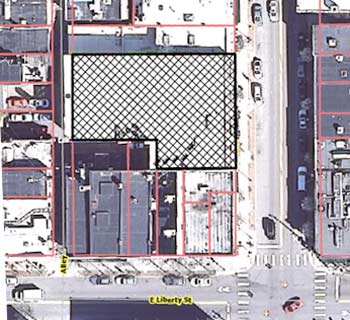
Aerial view of the Montgomery building (indicated with crosshatches) at 210 S. Fourth Ave. in downtown Ann Arbor.
City planner Matt Kowalski gave the staff report. The estimated $3.8 million project would expand the existing 17,273-square-foot building to 38,373 square feet, with housing on the second through fifth floors. The footprint of the existing building won’t change, and the ground floor would remain commercial space. Current tenants include Salon Vertigo and Bandito’s Mexican Restaurant. The top floor will include a stair/elevator lobby, restroom, wet bar, and access to several roof decks. Part of the fifth-floor roof will be covered in vegetation as a green roof.
The third-floor addition will be set back 11 feet from the existing building’s facade. The fourth floor will be set back an additional nine feet.
Because the building is located in an historic district, it required a certificate of appropriateness from the city’s historic district commission. The HDC granted that certificate at its Sept. 12, 2013 meeting.
The site is zoned D1, which allows for the highest level of density. According to a staff memo, eight footing drain disconnects will be required.
According to a report from the July 10, 2013 citizen participation meeting, the units will be marketed to “anyone who wants to live downtown.” If approvals are received, construction is expected to begin next summer.
Montgomery Building Apartments on S. Fourth: Public Hearing
Three people spoke during a public hearing on this project. Luke Norman, who lives on South Fourth Avenue, wondered if there would be any affordable housing in this development.
Brad Moore, the project’s architect, told commissioners that the project would rejuvenate the building. The plan is to completely reconstruct the facade and give it a look that’s “more characteristic of its heyday,” he said, while adding some additional stories to increase the amount of downtown residential space.
The hope is to also increase the amount of retail space along that section of Fourth Avenue, he said, in conjunction with the development at Fourth and Liberty. [Moore is also the architect for an expansion project on the adjacent property – a three-floor addition to the Running Fit building at East Liberty and South Fourth, which will create six residential units. That project received a recommendation of approval from planning commissioners at their Oct. 15, 2013 meeting but still needs city council approval.]
The proposed setbacks of the upper floors are intended to prevent a feeling of the building encroaching on the street, Moore said. He said he had additional information if the commissioners had any questions.
Ray Detter noted that the downtown citizens advisory council had looked at this project. The proposed changes will be a marvelous addition to that block, he said, and it’s a positive direction to restore something that’s part of the city’s past and will be part of its future. The advisory council strongly supports the addition of mixed-income housing in that part of the downtown, Detter said.
Montgomery Building Apartments on S. Fourth: Commission Discussion
Bonnie Bona began by taking up a question asked during public commentary: Is there any affordable housing in this project? Brad Moore replied that there’s nothing that would be dedicated affordable housing, but there are some studio apartments – at about 500 square feet apiece – that would have a lower rent than the other units, because of the smaller size. The one-bedroom apartments will average about 750-800 square feet, and the two-bedroom units will be about 950 square feet.
Bona said it would be nice to get some market-rate affordable units rather than subsidized affordable housing. She hoped that if the project is forwarded to the city council for approval, it would include pricing for the various units, relative to income levels. For example, would someone who makes 80% or 60% of the area median income be able to afford the rent?
Bona then asked about the building in relation to neighboring parcels. Moore explained that a portion of the building on the north and south sides will be built up to the property line. Bona wondered how it was possible to put in windows there, considering the fact that the building adjacent to this proposed expansion could also add additional floors someday.
Moore said that the developer will be applying for a variance from the building board of appeals in order to install windows on walls that aren’t set back from the property line. He indicated that a city building official has told him that it’s been the city’s practice to grant such a variance for a limited quantity of windows, with the caveat that additional fire sprinklers must be installed to prevent fire from shooting out the windows into the adjacent building.
There’s also the understanding that if the adjacent building increases in height, the windows would be blocked in, Moore said. There are other opportunities for light in the units, so the windows on those sides would be “supplemental,” he said.
Ken Clein confirmed with Moore that the windows on the property line would be non-operable. He also asked about exterior materials that will be used. [Clein is an architect, and typically asks about exterior materials.] Moore explained that some of the color choices were made in response to feedback from the historic district commission.
Wendy Woods asked about the west side of the building, facing a back alley. The units on that side have balconies over the alley – what would those balconies be facing? Moore replied that most of the buildings on the other side of the alley are three stories high. So balconies on the Montgomery Building’s second and third floors would be looking across the alley at other residential units. Moore confirmed for Woods that the trash pickup and recycling takes place in that alley.
In response to another query from Woods, Moore reported that the studio apartments will be in the building’s southwest corner.
Clein asked about the first floor “arcade,” and wondered if that configuration would remain. Moore noted that the arcade walkthrough ceased to exist 10 years ago, when the hair salon expanded across the back of the building. The rear entrance from the alley serves only the hair salon and as an emergency exit. He said there’s been no commitment to a specific layout, so it’s possible that they could reestablish the arcade walkthrough.
Diane Giannola asked if there would be any coordination in the construction of this project and the adjacent expansion at the corner of Fourth and Liberty.
It’s possible, Moore replied, though he noted that the buildings have separate ownership. The merchants on that street are sensitive about the sidewalks being closed all summer, so there’s an effort not to do that, he said. It depends on the timing of the construction for each project, however.
Jeremy Peters said he’s glad to see a project that could revitalize an area that seems to need some help. He liked the fact that the design would evoke the building’s historic facade, and was happy to see more density in the downtown core.
Bona asked about the building’s mechanicals. She said one deficiency in the city’s zoning code is a lack of requirements to screen the mechanical units. When screening does occur, it sometimes looks worse than just leaving the mechanicals exposed, she said.
Moore explained that there would be a screen of the rooftop mechanicals, behind the penthouse. The building will likely use a heat-pump system, he said, so that the only equipment mounted on the roof will be a boiler and a chiller. There will be a parapet around the perimeter of the roof that’s about two feet tall, and the mechanical screen will rise above that, but will be unenclosed at the top.
Bona wondered what it would look like if someone were to look down onto the roof from a taller building. Moore indicated that there might be room for potential solar panels toward the back of the roof, but three sides in front will have a green roof, wrapping around patios.
Sabra Briere asked about the noise that would be generated by the mechanicals. She hears from people about the noise caused by such heating and cooling elements, especially from residents whose units back up to shared alleys. Moore said he hoped the screening would address that to some extent. He didn’t know how many decibels the equipment would generate. Briere hoped he would keep the noise factor in mind as the project moved forward.
Clein noted that from his experience, most modern boilers and chillers are fairly quiet. [Clein is a principal with Quinn Evans Architects.] Condensers and pressers tend to make a lot of noise, he observed – but those won’t be used in this project. He wondered whether the mechanicals include an emergency generator. Moore replied that the generator will likely be located in the basement.
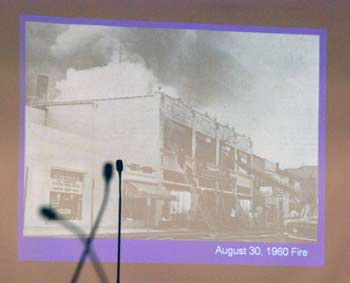
A slide from the city planning staff’s presentation showing a photo of the 1960 fire at the Montgomery Building on South Fourth Avenue.
Wendy Woods noted that fires had occurred in both the Montgomery Building and the adjacent Running Fit structure – was it the same fire? No, Moore replied. The fire at the Running Fit building pre-dated the Montgomery Building fire, which occurred in 1960. He noted that in doing historic research for this project at the Bentley Historical Library, he was amazed by how many buildings had burned in Ann Arbor. “It seemed to be a big problem,” he said.
Kirk Westphal said people were pleased that the building design respected the historical context. Referring to the city’s master plan, Westphal noted that it strongly encouraged active uses on the ground floor. He asked if the owners were willing to abide by those desires. “Absolutely,” Moore replied.
Westphal also asked about the contractor that would be used for this project – did they use local labor? Moore wasn’t certain but thought that they did. He noted that the contractor is a firm based in Ypsilanti.
Clein pointed out that despite the questions from commissioners, this is the kind of development that’s needed downtown and he hasn’t heard many people object to the project.
Outcome: Commissioners unanimously approved the site plan, which will now be forwarded to the city council for consideration.
Briarwood Mall Restaurants
Planning commissioners were also asked to recommend approval of a site plan and development agreement for two restaurants at Briarwood Mall. [.pdf of development agreement] The project was originally considered at the commission’s Oct. 15, 2013 meeting, but postponed because of outstanding issues.
Angeline Lawrence gave the staff report. The proposal calls for building two new freestanding restaurants – one at 6,470 square feet, the other at 7,068 square feet – on the east side of the Macy’s building at Briarwood Mall, 700 Briarwood Circle. The restaurants would be two chains: P.F. Chang’s and Bravo! Cucina Italiana.
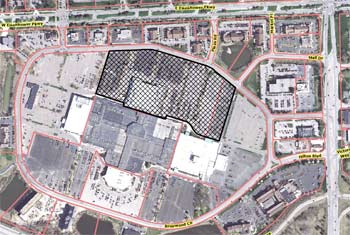
Aerial view of Briarwood Mall. The cross-hatched section indicates the parcel where two new restaurants are proposed, adjacent to Macy’s.
The parking lot north and east of the new restaurants would be reconfigured, reducing the total amount of parking by 188 spaces. Bicycle parking will be added to the north and west entrances to Macy’s.
The estimated cost of the project is $1,577,094. The site is located in Ward 4.
Originally, the planning staff had indicated that the project would require rezoning a portion of the parking lot from P (parking) to C2B (business service. However, according to a memo accompanying the commission’s Nov. 19 meeting packet, planning staff have subsequently determined that because the original 1973 Briarwood Mall zoning anticipated the expansion of Hudson’s (now Macy’s ) to the east, no rezoning is needed.
The city’s planning staff previously had recommended postponement in order to allow the developer to deal with some outstanding issues related to zoning, landscaping, easements and utilities. Those issues are now resolved, according to staff.
For example, concerns had been raised about the location of the area for trash and recycling. That area has been reconfigured and approved by the city’s solid waste staff. Also, plans were eliminated for a new detention pond on the northeast corner of the mall site, based on a recommendation by the Washtenaw County water resources commissioner. Instead, an existing detention pond on that site will be dredged and retrofitted.
Briarwood Mall Restaurants: Public Hearing
The only speaker during the public hearing for this project was Scott Richardson, representing the Briarwood Mall owners. He noted that he and the project’s engineer were on hand to answer any questions.
Briarwood Mall Restaurants: Commission Discussion
Bonnie Bona asked staff to explain how they interpreted “this convoluted site” during their review of the project. She described it as a fairly odd-shaped site, and some of the improvements are being included not just near the restaurants, but elsewhere around the Macy’s building. She clarified with staff that the improvements, such as adding landscape islands in the parking area, are being done in response to the addition of the two restaurants.
Planning manager Wendy Rampson pointed to a page in the meeting packet that showed the site configuration of the mall and indicated each parcel’s ownership. [.pdf of site configuration] She said that at the Oct. 15 meeting, the planning staff was still struggling to understand how the parcel configuration ended up that way. As far as staff can tell, the parcels inside the mall’s “ring road” never went through a formal land division process, she said. “That was what we tried to untangle.”
Macy’s owns the land where the restaurants are proposed, Rampson explained, so the mall owners – Simon Company – are buying and developing that parcel.
Bona then asked Scott Richardson about the future development of the mall. It’s important to make sure that “we’re not boxing ourselves into something that looks like the past, instead of like the future,” she said. Bona wondered whether the mall site’s subdivisions would prevent the site from more progressive development in the future.
Richardson replied that when the company looks at a master plan for any mall that it’s developing, “we tend to lose sight of the property lines.” When there’s a “win-win” for all of the parties involved, he said, “there’s ultimately a deal that can be done” to allow for what he called “grand development.” Even though parcel lines might change, nothing being done for this restaurant deal will eliminate the possibility for anything in the future, he said. Representatives for Simon Company meet at least quarterly with representatives from the key department store companies, he said, to talk about issues that arise, including opportunities for future development.
As an example, it would be possible to develop the property so that the road in front of the two new restaurants becomes “like an intimate Main Street,” Richardson said, with additional shops, restaurants – or even a parking structure with some residential units above it, built to face the street. He said that everyone recognizes the fact that a lot of parking is underused, and a lot of the site is undervalued and can be improved. It’s not a change that happens quickly, he added, but it’s something “that we certainly have on our plate, to make sure that we think big picture – because the last thing you want to do is sell yourself short in the future for a bird in the hand today.”
Bona said she was glad Richardson “could see more optimism here than I’m seeing, so I’ll take you at your word.” She then asked about the number of trees and bioswales on the site, saying that at first glance it seemed to her to be in excess of what would be required by the two new restaurant buildings. She noted that it seemed to relate to the fact that two parcels were impacting this development – a parcel owned by Macy’s, a the parcel owned by Simon Company.
City planner Angeline Lawrence replied that 169 trees are required by code for the Macy’s parcel, but the city allowed the developer to count some of the existing trees on the site as part of that total. That means that only 133 trees will be added, she said.
Bona also wondered how the regional detention system worked. Lawrence replied that the existing detention pond is just to the north of the proposed new restaurant site. There’s a similar pond on the other side of Briarwood Circle, she said. The plan calls for dredging sediment from the bottom of the existing detention pond that’s near the to-be-developed site, and to install a new pipe that would allow runoff to flow into that pond.
Rampson added that when Briarwood Mall was developed, a regional detention system was created for the whole area. The detention ponds drain east into Malletts Creek.
Jeremy Peters asked about a possible scenario in which one of the core companies at the mall goes out of business, and was sold to a “less cooperative” holding company. Would the property lines pose any problems in that case? Richardson replied that the property lines have nothing to do with what happens in that situation. There are legally binding documents between the mall developer and the property owner, he explained, that restrict what a retailer can or can’t do with their property. There would also be a dialogue between Simon Company and the retailer, he said, because Simon Company has more invested in Briarwood Mall than any individual retailer, and would “vigorously” protect its asset.
Saying that she frequented the mall, Eleanore Adenekan asked about handicapped parking spaces. Richardson assured her that all of the spaces are being designed to meet current Americans with Disabilities (ADA) codes.
In response to a query from Ken Clein, the project’s engineer – Gary Tressel, with the engineering firm of Hubbell, Roth & Clark in Bloomfield Hills – explained that the lights in the parking lot at Macy’s will be retrofitted with LED fixtures. The new parking area will also have LED fixtures.
Noting that it wasn’t directly related to this project, Wendy Woods asked about a new skating area at the mall. Richardson replied that an inside “faux ice” skating rink was installed in the mall near the JC Penney store. He described how skaters use special shoes with pads to simulate ice skating.
Outcome: The site plan and development agreement was unanimously approved. The proposal will be forwarded to city council for consideration.
Present: Eleanore Adenekan, Sabra Briere, Bonnie Bona, Ken Clein, Diane Giannola, Paras Parekh, Jeremy Peters, Kirk Westphal, Wendy Woods. Also: City planning manager Wendy Rampson.
Next regular meeting: Tuesday, Dec. 3, 2013 at 7 p.m. in the second-floor council chambers at city hall, 301 E. Huron St., Ann Arbor. [Check Chronicle event listings to confirm date]
The Chronicle survives in part through regular voluntary subscriptions to support our coverage of publicly-funded entities like the city’s planning commission. If you’re already supporting The Chronicle, please encourage your friends, neighbors and coworkers to do the same. Click this link for details: Subscribe to The Chronicle.




